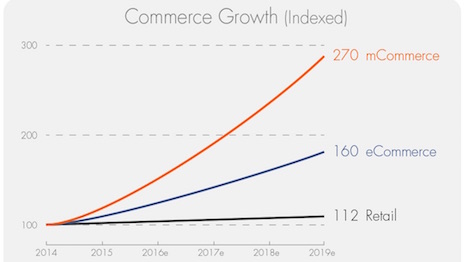
Despite mcommerce’s tremendous growth, monetization is lagging behind desktop commerce. Source: AppLift analysis
By Stefan Benndorf
Mobile commerce is growing, but it could be – even should be – growing faster.
The mcommerce gap is the monetization gap that exists between consumers’ mobile browsing habits and their mobile buying.
In other words, based on how often consumers use their mobile devices to shop, there is tremendous opportunity to increase how often they actually make a purchase, as well as how much they spend.
Global online sales are predicted to reach nearly $2 trillion in 2016, but that is still less than 10 percent of the total global retail market, according to research from eMarketer.
Mobile usage surpassed desktop in 2014, but shopping patterns have not quite caught up. Consumers are still making more purchases and spending more money via desktop.
 On an equalized usage basis, mcommerce apps and Web sites are generating just 70 percent of purchase activity and 30 percent of the transaction volume of desktop ecommerce Web sites. Sources: AppLift analysis, comScore, U.S. Census Bureau and Criteo
On an equalized usage basis, mcommerce apps and Web sites are generating just 70 percent of purchase activity and 30 percent of the transaction volume of desktop ecommerce Web sites. Sources: AppLift analysis, comScore, U.S. Census Bureau and Criteo
Some of the gap can be attributed to customer preferences and hesitations about making mobile purchases. Fortunately, there are ways for retailers to address the lag.
To capitalize on the mcommerce opportunity, retailers cannot treat mobile as a secondary channel. They need to prioritize their mobile commerce approach. Let us take a look at three factors affecting retailers’ ability to drive mobile transactions.
1.
Customer acquisition
Mobile application usage is growing faster than the retailer app adoption rate. Customers are willing to download and engage with transactional apps, but many retailers are still slow to develop them.
As a vertical, retail can be slow to adopt mobile best practices in user interface, user experiences and payment – factors that affect whether or not a customer will shop via mobile.
Plus, many retailers, as well as many other verticals, still prioritize their desktop user acquisition strategy over mobile and simply are not investing enough resources in their mobile approach.
2.
Engagement
Bounce rates are about 10 percent to 20 percent higher on mobile than they are on desktop.
Users visit significantly fewer pages in apps than they do on computers. This has a lot to do with the way that consumers engage with their phones. They have shorter session times on mobile than they do on desktop, but they use their mobile devices much more frequently.
Retailers and all businesses need to develop engaging app experiences created with the nuances of mobile in mind to drive maximum action, including transactions.
3.
Retention
On mobile, it can be tricky to re-engage a user once you have lost him or her.
Users are less likely to return to a page or an app after visiting a product site than they are on desktop. This can make it challenging to drive people down the purchasing funnel.
Improve mobile site and mobile app funnel metrics
In short, the mcommerce gap stems from problems driving conversations once a retailer has connected with a user, not to mention the challenge of acquiring potential mobile customers in the first place.
There are steps retailers can take to better capitalize on the mcommerce opportunity.
For starters, they need to create mobile transactional apps, as users spend the majority of their mobile time in apps, and mobile apps also have higher conversion rates than the mobile Web.
Retailers also need to ensure they have user-friendly, optimized mobile experiences across all of their mobile content.
Businesses can repurpose some of their desktop performance marketing tactics for use on mobile.
Retargeting, one of the most effective strategies for driving desktop conversions, can be used effectively on mobile.
The same desktop best practices apply: set up a retargeting strategy based on CRM data and product feeds to re-connect with consumers whom you have previously engaged with to drive conversions.
Retailers can also drive mobile commerce by creating more-efficient approaches to mobile attribution.
There are a variety of attribution tools on the market that help businesses better understand and optimize their purchasing funnel, just as they do on desktop.
Although cross-device attribution is still in its infancy, it shows great promise for helping advertisers spend more wisely by better understanding the relationship between channels.
For example, a desktop purchase could have actually been inspired by a mobile ad. Advertisers will have an easier time driving results if they can see the big picture.
THESE DAYS, consumers are nearly tethered to their mobile devices. They use them to communicate, for entertainment, for work, to seek information, so why not to shop?
Retailers can make the most of mcommerce’s potential and accommodate their customers’ preferences by making mobile shopping simple.
Retailers that invest in user experience, measurement tools and performance advertising solutions will be able to create and control their mobile transaction funnels most effectively and ultimately bridge the mcommerce gap.
 Stefan Benndorf is managing director and chief operating officer of AppLift
Stefan Benndorf is managing director and chief operating officer of AppLift
Stefan Benndorf is managing director and chief operating officer of AppLift, Berlin, Germany. Reach him at stefan@applift.com.
 Despite mcommerce’s tremendous growth, monetization is lagging behind desktop commerce. Source: AppLift analysis
Despite mcommerce’s tremendous growth, monetization is lagging behind desktop commerce. Source: AppLift analysis
 On an equalized usage basis, mcommerce apps and Web sites are generating just 70 percent of purchase activity and 30 percent of the transaction volume of desktop ecommerce Web sites. Sources: AppLift analysis, comScore, U.S. Census Bureau and Criteo
On an equalized usage basis, mcommerce apps and Web sites are generating just 70 percent of purchase activity and 30 percent of the transaction volume of desktop ecommerce Web sites. Sources: AppLift analysis, comScore, U.S. Census Bureau and Criteo Stefan Benndorf is managing director and chief operating officer of AppLift
Stefan Benndorf is managing director and chief operating officer of AppLift